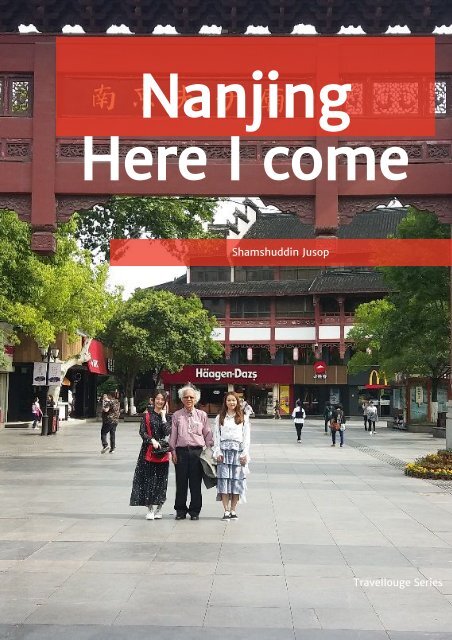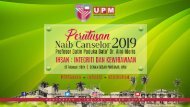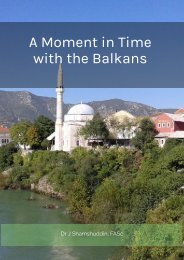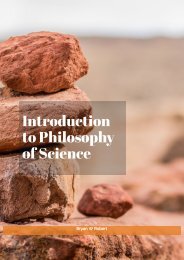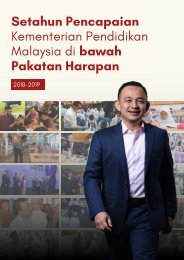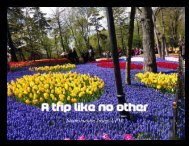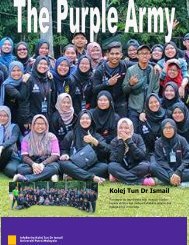Nanjing++by+Shamshuddin+Jusop_2744
You also want an ePaper? Increase the reach of your titles
YUMPU automatically turns print PDFs into web optimized ePapers that Google loves.
Nanjing<br />
Here I come<br />
Shamshuddin Jusop<br />
Travellouge Series
Nanjing<br />
Nanjing Here I come<br />
Shamshuddin Bin Jusop<br />
Mention China in any meeting everywhere in the world, right away<br />
something comes out of our mind. First and foremost, China is a<br />
new industrial giant in the East that matches the might of or could<br />
bring United States to its knees in not too far distant future. That<br />
it is so is evidenced by her rapid rate of industrialization and<br />
economic output comparable to none in the East and West.<br />
Be that as it may, China is generous and willing to share her<br />
wealth/bounty with the rest of the world, especially with the people<br />
in Southeast Asian countries, e.g. Malaysia, Indonesia and Thailand.<br />
Recently, I was in Nanjing to attend a forum and to meet as well as<br />
having a meaningful discussion with my research collaborators in<br />
Nanjing Agricultural University (NAU).<br />
Nanjing
Nanjing<br />
Let me say this, if I may. For all you know, right now NAU is one of best in business in the field of<br />
agricultural sciences in China. The 2019 International Forum on Innovations in Food, Land, Energy<br />
and Water System in Asia held at Jiangsu Conference Center, Nanjing on May 22-25, 2019 was a<br />
special initiative to show to the world that China is keeping her promise.<br />
I went to China this time around to get to know the prime movers and others attending the very<br />
important Nanjing meeting and to take note of what was going on in the meeting. Hopefully,<br />
Malaysia would be joining them in future meetings or dialogues.<br />
My trip to Nanjing was made possible by a special fund, courtesy of Professor Ziaorong Fan from the<br />
College of Resources and Environmental Sciences, Nanjing Agricultural University, Nanjing.<br />
Nanjing
Nanjing<br />
A special photo taken for the album with Professor Fan (middle)<br />
Nanjing
Nanjing<br />
I have been told that NAU is one of best<br />
agricultural universities in China. Well, it<br />
sure is considering its strategic location in<br />
China – Nanjing is one of the former<br />
capitals of the imperial China. With the<br />
student population of about 40,000, NAU<br />
has what it takes to be a university par<br />
excellence in future.<br />
I have visited the laboratories where<br />
Professor Fan was working and I was<br />
impressed by the kind of research and<br />
development the academics and students<br />
there were conducting, trying to solve the<br />
problems facing agricultural production in<br />
the country.<br />
By the way,<br />
Professor Fan is<br />
a trained and/or<br />
renowned<br />
molecular<br />
biologist in<br />
China. I may<br />
not understand<br />
much of what<br />
she has being<br />
doing in the<br />
sophisticated<br />
laboratories of<br />
the College of<br />
Resources and<br />
Environmental<br />
Sciences of<br />
NAU, but we<br />
can rest assured<br />
that the results<br />
of her<br />
research/studies<br />
have<br />
contributed<br />
greatly to<br />
nation building<br />
for the good of<br />
mankind.<br />
Nanjing
Nanjing<br />
At the Main Gate of NAU with Professor Fan and her colleague<br />
This trip to Nanjing was my fourth to China. The first one was way back in mid-1990s to attend the<br />
30<br />
th<br />
International Geological Congress which was held in downtown Beijing, the current capital city of<br />
China. The next two trips were to attend soil conferences in Guangzhou.<br />
Nanjing
Nanjing<br />
I was impressed by the rapid growth in Chinese industrial and economic development – to me it is<br />
second to none in the East, except Japan. Thanks to the good leadership in the government whose<br />
great vision was responsible for starting industrial revolution at the beginning of the new century. It<br />
will continue to be so in the future that will make China great, like it once was. I am sure it will.<br />
In the afternoon of May 24, 2019, I took a break from the forum to visit the well-known Imperial<br />
Examination Museum of China in Nanjing. I was by accompanied by three NAU students – a man and<br />
two ladies. We walked through the streets of Nanjing to get to the popular tourist destination in<br />
downtown Nanjing.<br />
The museum, dedicated to the Imperial Examination System, is big by any standard. It is known that<br />
the best few students who passed the examination were rewarded with good job by the emperor to<br />
serve the empire. Some of them were even o ered a hand in marriage to princesses. For that very<br />
reason, many had tried their luck by taking the examination.<br />
A picture taken at the Main Gate of Nanjing with two NAU lady students<br />
Nanjing
Nanjing<br />
Me with Choi Yoon Soo who is Professor Fan’s PhD student from Korea<br />
The two ladies (students) who showed me around in the museum<br />
Nanjing
Nanjing<br />
The scholars in full concentration to answer the examination questions<br />
I was dressed to kill by wearing the special costume meant for the graduates<br />
Nanjing
Nanjing<br />
When the imperial examination was done and over with<br />
Besides attending the afore-mentioned forum, Professor Fan requested me to deliver a<br />
seminar on my recent work to the academics and students of the College of Resources and<br />
Environmental Sciences, which I did on the morning of May 25, 2019.<br />
Professor Sun Yue working in Beijing whom I was<br />
supposed to meet in Nanjing came to listen to<br />
the seminar. I was glad to see him there. Later,<br />
he and I accompanied by another lady student<br />
went to the world-class Nanjing Museum.<br />
Nanjing
Nanjing<br />
A photo taken in front of the poster announcing the seminar I was going to deliver<br />
A photo taken after the seminar with Professor Fan (2 from left)<br />
nd<br />
and Professor Sun Yue (2 from right)<br />
nd<br />
Nanjing
Nanjing<br />
In my view, the visit to Nanjing Museum was equally interesting. Professor Sun told me that the<br />
museum of antiquity was the 2<br />
nd<br />
biggest in China. See, Professor Sun is a professor of English<br />
Literature at the College of Foreign Languages, Capital Normal University in Beijing, which is a 4-hour<br />
train ride away from Nanjing.<br />
I was introduced to him by Mr Chee Keong Tan, who is an o cial of the Ministry of Education in<br />
Putrajaya, Malaysia. Both Professor Sun and Mr Tan are interested in Big History. Mr Tan knew that I<br />
was going to NAU for a conference/meeting on May 23, 2019 and asked Professor Sun to meet me<br />
there if he could.<br />
After my seminar at NAU, I gave Professor Sun a copy my book “The Earth Story”. He wanted to take<br />
a few points on the creation of the universe from the perspective of Islam, which I wrote in the book.<br />
During the visit to the museum, Professor Sun explained to me a lot on the history of the imperial<br />
China of which he is an expert. We talked a lot about other things as well, including life, nation<br />
development and the use Big History for the good of mankind. It was really good to get to know him<br />
and we talked as if we have already known each other for many long years. How amazing!<br />
China is what China is. Her imperial influences is not new to the Southeast Asian region or the Malay<br />
Archipelago, if you like. Trade and collaboration, political or otherwise, had existed since time<br />
immemorial. It was in 15<br />
th<br />
Century that trade thrived well between the two regions when Melaka<br />
Empire of the Malay World was at its height. Ships from the East, India and Arab lands met at Melaka<br />
Port to exchange goods of all kinds, including silk, spices, etc.<br />
The legend has it that Sultan Mansur Shah of Melaka (1456-1477) had a marriage of convenience to<br />
Princess Hang Li Po of Imperial China; it was during the time of Ming Dynasty. The lady from the<br />
Court of China was believed to have been sent to Melaka after the Sultan requested for help to stop<br />
Thailand from disturbing the newly established kingdom in the Malay Peninsula. After the marriage,<br />
there was no more disturbance from the Thais and the kingdom continued to flourish.<br />
The princess together with her followers were accommodated in a special settlement (a hilly area<br />
known as Bukit China). But please take this story with a pinch of salt. There is no written record<br />
whatsoever has been found either in Malaysia or China. However, if this legend is anything to go by,<br />
China and Melaka, a state in the present day Peninsular Malaysia, had already involved in some kind<br />
of military collaboration/alliance even in the 15<br />
th<br />
Century. Hence, my proposed study on sustainable<br />
rice cultivation using sea water a ected soils in Malaysia with the help of the academics of NAU is a<br />
continuation of what was once existed between the two empires.<br />
To start the research collaboration between NAU and UPM, Professor Fan and her team of researchers<br />
paid a courtesy visit to UPM in late January 2019. She explained elaborately the purpose of the visit<br />
and showed us via a seminar the work she had been doing at her university, NAU.<br />
Nanjing
Nanjing<br />
Based on her presentation, we were excited/impressed and willing to be part of the winning team<br />
working on rice production. A research proposal has been submitted to the Chinese government to<br />
get fund to study rice production on sea water a ected soils. This is what I called a “Long-Term<br />
NAU-UPM Research Collaboration on Rice Production”.<br />
What happens if the application for the research fund is rejected by the powers-that-be? Such being<br />
the case, we should be thinking about an alternative research project to keep things going between<br />
the institutions.<br />
The rational of such a new project is that global warming results in significant sea level rise<br />
throughout the world, especially in Southeast Asian countries. Future sea level rise in the region is for<br />
real. During pre-Industrial Revolution period, the concentration of CO 2 in the air was about 250 ppm.<br />
Now it is more 400 ppm and it continues to rise by the years. The increased concentration of CO 2 in<br />
the air is one of the factors causing global warming, which in turn, results in sea level rise. In<br />
Malaysia, 0.5-1.0 m sea level rise is expected by the year 2100.<br />
This phenomenon results in sea water inundating the low-land areas in the coastal plains of the<br />
country. Hence, rice fields along the coastal plains will be flooded severely by sea water that<br />
negatively a ects rice production. This will threaten food security in the long run. The solution to the<br />
problem is growing sea water tolerant rice variety in the a ected areas.<br />
There is a worry though of the viability of such a mammoth project due to so many scientists needed<br />
to realize the dream. Is it possible to set up a credible team of researchers from NAU and UPM to<br />
work on the project within a reasonable time frame?<br />
To be successful, a rice variety that can withstand sea water stress has to be produced by the end of<br />
the study. Soon thereafter, it has to be tested on the soils in the a ected areas to determine its yield<br />
and the cost of production.<br />
A project of this nature requires many scientists specializing in:<br />
1) Molecular biology and genetics;<br />
2) Marine sciences;<br />
3) Agronomy and postharvest;<br />
4) Plant protection;<br />
5) Soil science and/or land use;<br />
6) Plant nutrition; and<br />
Nanjing
Nanjing<br />
7) Agri-business –<br />
to evaluate the viability in terms of production and cost. To be cost-e ective and sustainable, this<br />
research has to be conducted in both China and Malaysia. This is because sea level rise is a global<br />
phenomenon. Everybody will be a ected in some ways or another. Working collaboratively among the<br />
a ected nations is the way forward. Well, it is up the would-be sponsor to consider the proposal.<br />
Remember, food security in the world is threatened by the calamity; hopefully, the proposed project<br />
will find a solution to the problem.<br />
If a project of this nature is over ambitious, we can always modify to suit our dream without<br />
necessarily abandoning the set objectives. For sure, it requires a lot of brain power to come out with a<br />
comprehensive proposal that will satisfy the sponsor. We never know, in the end it may need<br />
government to government intervention.<br />
But no harm is done trying, I guess. In my view, if we want to serve mankind and to be known for a<br />
lifetime, this is one of the projects we should be thinking about and doing for the next many years of<br />
our academic life. I guess not many in the world have given a serious thought on conducting a<br />
research of this nature yet. Thus, let NAU-UPM research on rice production during the di cult time<br />
be the pioneer. It will be great.<br />
As far as NAU is concerned, it is a true-blue agricultural university in the East. For all you know, a set<br />
for agricultural production is not complete without the services provided by agricultural engineering<br />
(designing machinery and mechanization) and veterinary medicine (looking after animal health).<br />
In fact one of the biggest structures within its city campus in Nanjing is Veterinary Medicine and<br />
Animal Science Building. It shows how important animal production is to the country. So under the<br />
Look East Policy, which the Malaysian Government is now promoting, we should not only look<br />
towards Japan/Korea, but also to China for advanced education in S&T.<br />
Thus, I suggest Universiti Putra Malaysia should sign MoU with Nanjing Agricultural University in due<br />
course so as to strengthen the collaboration in R&D between the two institutions. The results of the<br />
research collaboration that followed would benefit mankind throughout the world.<br />
Nanjing
Nanjing<br />
Professor Fan showing a helicopter designed by NAU agricultural engineers<br />
equipped with data logger using drone tech to monitor crops growing in the fields<br />
during her seminar at UPM in January 2019<br />
Nanjing


